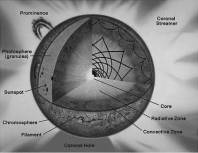| RXTE GOF |
High Energy Groovie Movie | RXTE FAQ |
|---|
High Energy Groove
How Hot is One Million Degrees Kelvin?
Level: Grades 7-9 Author: Kimberly S. Adams, Argyle Middle School, Silver Spring, MD
National Science Education Standards:
http://www.nap.edu/readingroom/books/nses/html/index.html
Science as Inquiry: Understandings about Scientific Inquiry (grades 5-8)
Physical Science: Transfer of Energy
The sun is a major source of energy for changes on the earth's surface. The
sun loses energy by emitting light. A tiny fraction of that light reaches the
earth, transferring energy from the sun to the earth. The sun's energy arrives
as light with a range of wavelengths, consisting of visible light, infrared,
and ultraviolet radiation. (Grades 5-8)
In most chemical and nuclear reactions, energy is transferred into or out of a system. Heat, light, mechanical motion, or electricity might all be involved in such transfers. (Grades 5-8)
Science and Technology: Understandings about Science and Technology
Scientists in different disciplines ask different questions, use different
methods of investigation, and accept different types of evidence to support
their explanations. Many scientific investigations require the contributions
of individuals from different disciplines, including engineering. New
disciplines of science, such as geophysics and biochemistry often emerge at
the interface of two older disciplines. (Grades 9-12)
Enduring Understanding:
In order for the sun to emit X-rays the temperature must rise to one million
degrees Kelvin.
Essential Question:
How hot is one million degrees Kelvin converted into Fahrenheit and Celsius?
Objective:
The students will covert various temperatures between the Fahrenheit, Celsius,
and Kelvin scales.
Background:
http://imagine.gsfc.nasa.gov/docs/science/know_l1/xray_sun.html
Materials:
- Thermometer (lab)
- Thermometer (oral)
- Ice water
- Ground soil (outside)
- Access to indoor and outside temperature
Warm up:
Draw and label the structure of the sun.

Procedure:
- Review and discuss "The Coronal Heating Problem." (http://imagine.gsfc.nasa.gov/docs/science/know_l1/xray_sun.html)
- Reinforce the information that we do know: We know that the sun emits x-rays. We know that temperatures must rise to one million degrees Kelvin in order to emit x-rays. We know that the surface temperature of the sun is only 6000 degrees Kelvin and that the temperature of the corona is over 1,000,000 degrees Kelvin.
- Therefore, the question of the day is, how hot is 1,000,000 degrees Kelvin?
- In order to complete the activity sheet, students will need to complete mathematical conversions. Therefore, depending on the level of students, a quick math review may be in order.
- Students will complete the first eight conversions to practice on their own.
- The last five conversions will require students to actually take the temperature of various objects around the school.
Assessment:
Check and review the activity sheet and graph as a class.